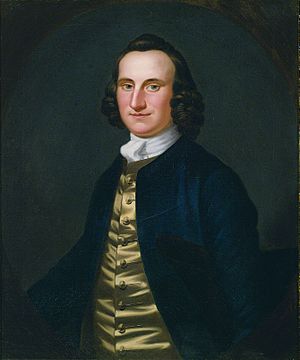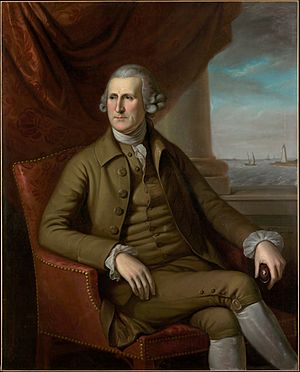Thomas Willing facts for kids
Quick facts for kids
Thomas Willing
|
|
|---|---|
 |
|
| President of First Bank of the United States | |
| In office October 25, 1791 – November 10, 1807 |
|
| President | George Washington John Adams Thomas Jefferson |
| Preceded by | Position established |
| Succeeded by | David Lenox |
| President of Bank of North America | |
| In office January 7, 1782 – March 19, 1791 |
|
| President | George Washington |
| Preceded by | Position established |
| Succeeded by | John Nixon |
| Mayor of Philadelphia | |
| In office October 4, 1763 – October 2, 1764 |
|
| Preceded by | Henry Harrison |
| Succeeded by | Thomas Lawrence |
| Personal details | |
| Born | December 19, 1731 Philadelphia, Province of Pennsylvania, British America |
| Died | January 19, 1821 (aged 89) Philadelphia, Pennsylvania, U.S. |
| Resting place | Christ Church Burial Ground |
| Spouse |
Anne McCall
(m. 1763; |
| Children | 13, including Ann and Mary |
| Relatives | Charles Willing (Father) James Willing (Brother) Mary Willing Byrd (Sister) Elizabeth Willing Powel (Sister) Edward Shippen (Great-grandfather) |
| Education | Inner Temple |
Thomas Willing (born December 19, 1731 – died January 19, 1821) was an important American businessman and leader. He served as the mayor of Philadelphia. He was also a representative for Pennsylvania in the Continental Congress. Later, he became the first president of two major banks: the Bank of North America and the First Bank of the United States.
Contents
Early Life and Education
Thomas Willing was born in Philadelphia. His father, Charles Willing, was also a mayor of Philadelphia. His mother was Anne Shippen. Her grandfather, Edward Shippen, was Philadelphia's second mayor. Thomas had a brother, James Willing, who was also a merchant. James led a military trip in 1778. This trip raided British loyalist properties in Natchez, Mississippi.
Thomas went to school in Bath, England. After that, he studied law in London at a famous place called the Inner Temple.
A Career in Business and Politics
In 1749, Thomas Willing came back to Philadelphia. He started a business with Robert Morris. Their company, Willing, Morris and Company, began in 1757. They traded many goods. They sent things like flour, wood, and tobacco to Europe. They brought in sugar, rum, and molasses from other places. Their business partnership lasted until 1793.
In 1768, Thomas Willing was chosen to join the American Philosophical Society. This was a group for smart people who wanted to share ideas.
Serving the Public
Thomas Willing was very active in public service. In 1755, he joined the city council. By 1759, he became an alderman. This meant he was a senior member of the city government. He also served as a judge in the city court.
In 1763, Thomas Willing became the Mayor of Philadelphia. He helped lead the city. Later, in 1767, he was appointed a justice for the Supreme Court. He served in this role until 1767.
Role in the American Revolution
Thomas Willing was part of the Committee of Correspondence in 1774. He also joined the Committee of Safety in 1775. These groups were important during the time leading up to the American Revolution.
He served in the Continental Congress. This was the group of leaders from the American colonies. In 1775 and 1776, he voted against the Declaration of Independence. However, he later gave a large sum of money (£5,000) to help the American cause. This money helped supply the soldiers fighting for independence.
Leading Banks
After the American Revolutionary War, Thomas Willing became a very important banker. From 1781 to 1791, he was the president of the Bank of North America. This was a very early bank in the United States.
Then, in 1791, he became the first president of the First Bank of the United States. He led this bank until 1807. In August 1807, he had a small stroke. Because of his health, he stepped down from his role as bank president in November 1807.
Family Life


In 1763, Thomas Willing married Anne McCall. They had thirteen children together. Some of their children included:
- Anne Willing (1764–1801), who married William Bingham.
- Thomas Mayne Willing (1767–1822).
- Elizabeth Willing (1768–1858), who married William Jackson.
- Mary Willing (1770–1852), who married Henry Clymer.
- Dorothy Willing (1772–1842), who married her cousin, Thomas Willing Francis.
- George Willing (1774–1827).
- Richard Willing (1775–1858).
- Abigail Willing (1777–1841), who married Richard Peters.
Thomas Willing passed away in 1821 in Philadelphia. He is buried at the Christ Church Burial Ground.
See also
 In Spanish: Thomas Willing para niños
In Spanish: Thomas Willing para niños

